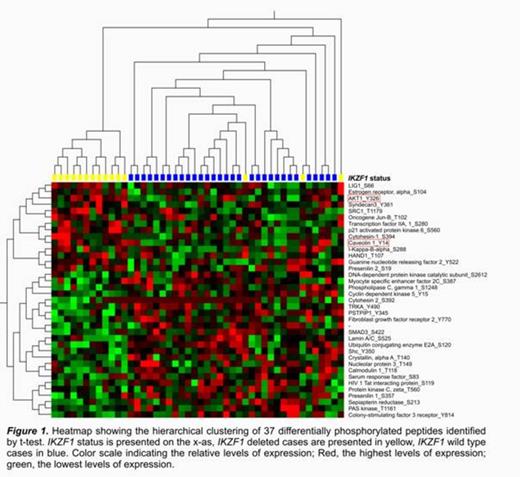Abstract
Overall survival rates for children with Acute Lymphoblastic Leukemia (ALL), the most common type of leukemia in children, are approaching 90% (Mullighan 2013). In the past 5 years, genome wide approaches, studying DNA copy number alterations in ALL, have increased the list of risk stratifications and included IKZF1 deletions to the list of unfavorable prognostic factors. IKZF1 deletions can be identified in approximately 70% of the Philadelphia chromosome-positive (Ph+) and in 15% of the Philadelphia chromosome-negative (Ph-) children with ALL and are associated with an increased risk on relapse and a decreased overall survival (Mullighan 2009, Kuiper 2010, van der Veer 2013). IKZF1 deletions observed in B-cell precursor ALL (BCP-ALL) are typically mono-allelic, resulting in the expression of a dominant-negative isoform (Mullighan 2008). A unique gene expression signature was revealed in IKZF1 deleted BCP-ALL patients, characterized by the downregulation of genes regulating B-cell lineage development and DNA repair upon DNA damage response genes and upregulation of cell cycle/apoptosis genes, JAK/STAT signaling and stem cell self-renewal (Iacobucci 2012). At the level of signal transduction, western blot analysis showed that IKZF1 deletions resulted in B cell receptor (BCR) signaling defects and upregulation of phospho-STAT5 in 2 and 4 Ph+ ALL patients, respectively (Trageser 2009, Iacobucci 2012). However, effects of IKZF1 deletions on signaling pathways in Ph-ALL have not been extensively studied.
Pediatric Ph- BCP-ALL patients (N=46) were screened for IKZF1 deletions by multiplex ligation-dependent probe amplification analysis. A total of 15 patients carried an IKZF1 deletion. We performed a kinase activity profile (IKZF1 deleted N=15, IKZF1 wild type N=31) as well as a human phospho-proteome array (IKZF1 deleted N=11, IKZF1 wild type N=17) to elucidate active signal transduction pathways.
Kinase activity profiling is a potent high throughput technique using peptides of 11 amino acids in length representing known human phosphorylation sites. In the obtained kinase activity profiles we studied differences in peptide phosphorylation intensities. 37 peptides were differentially expressed between IKZF1 deleted and wild type pediatric Ph- BCP-ALL patients (P ≤ 0.05, Figure 1). From these 37 peptides we first examined peptides derived from proteins involved in the BCR signaling and STAT5. On the kinome array, peptides derived from Src_Y352, CBL_Y371, SYK_Y526, PLCg2_Y753, PLCg2_Y1217, STAT5a_S780, STAT5a_Y694, and STAT5b_Y679 were present but showed no differences in phosphorylation intensities between IKZF1 deleted and IKZF1 wild type Ph- BCP-ALL samples. Neither could we detect differences in phosphorylation intensities of Fyn_Y420, Lyn_Y397, Src_Y419, STAT5a_Y694, STAT5b_Y699, and STAT5a/b_Y694/Y699 using human phospho-proteome arrays, confirming the kinome profiling results. We did, however observe a distinct kinome profile upon hierarchical clustering of 46 BCP-ALL primary samples, based on the 37 peptides identified by t-test (Figure 1). IKZF1 deleted cases showed high phosphorylation of 14 peptides including peptides derived from Akt1_Y326 and Cav1_Y14 (Figure 1). Loss of IKZF1 has been associated with glucocorticoid resistance. Since Akt inhibition reverses glucocorticoid resistance in T cell ALL (Piovan, 2013) and Caveolin 1 is involved in focal adhesion and chemoresistance (Faggi, 2014) we hypothesize that Akt and Caveolin 1 inhibition might convert glucocorticoid resistance in Ph-IKZF1 deleted pediatric BCP-ALL, which requires further investigation. Together, we conclude that kinome profiling revealed a distinct peptide phosphorylation pattern for IKZF1 deleted pediatric Ph- BCP-ALL including novel therapeutic targets.
No relevant conflicts of interest to declare.
Author notes
Asterisk with author names denotes non-ASH members.


This feature is available to Subscribers Only
Sign In or Create an Account Close Modal